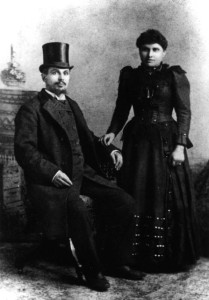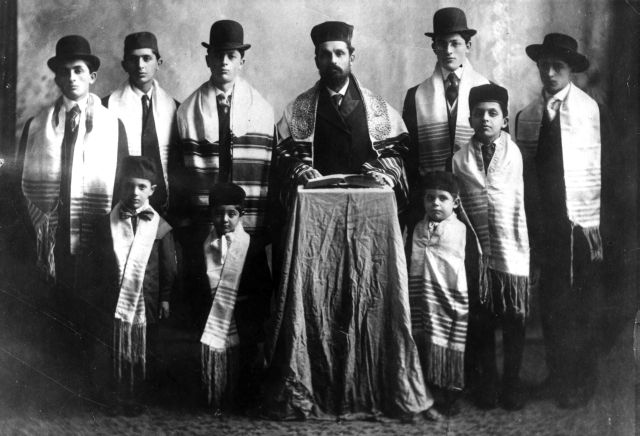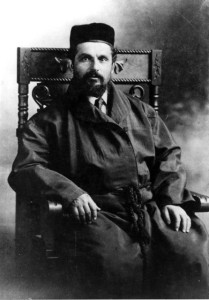“Reverend” Benjamin Papermaster

“Reverend” Benjamin Papermaster & Anna Levito’s Wedding Photo at Grand Forks, North Dakota, 1892 #WS0230.
Values Codes I – H – E – L – P
Benjamin Papermaster was born in 1860 in Anolova, near Lovno, Lithuania, then part of the Russian Empire.
Rabbi Benjamin Papermaster received his smicha (rabbinic ordination) at the age of 18.
Papermaster was also trained as a mohel (ritual circumcisor), a schochet (ritual slaughterer), and a cantor.
In 1890, Rabbi Benjamin Papermaster was called to Kovno by the Chief Rabbi, where he was introduced to the Zurakov family, who were going to America and wanted a trained rabbi for their community.
The Chief Rabbi told Rabbi Papermaster that it was his duty to go and help this new American community develop spiritually.
Along the way . . .
Rabbi Benjamin Papermaster arrived in New York early, in 1891, and headed West to Fargo, North Dakota, where he immediately applied to begin the process for citizenship, which he received in 1896 in Grand Forks, North Dakota.
His family was to follow when he was established.
Arriving in Fargo with his luggage and a sefer Torah (Torah scroll), Papermaster found a Jewish community of about 15 families.
Papermaster moved shortly thereafter to Grand Forks, just north of Fargo, where there were about 70 Jewish families.
Upon his arrival, the Jewish Community quickly organized a congregation, named it Congregation of the Children of Israel, and rented a hall downtown for the High Holy Days. The Congregation was later renamed B’nai Israel.
Grand Forks would be Reverend Benjamin Papermaster’s “base of operations” for the next 53 years.
For most of the time, Papermaster was the only Rabbi in North Dakota and Western Minnesota.
In the tradition of the times, he preferred the title of “Reverend” instead of “Rabbi.”
In 1895 he accepted a position in Sioux City, Iowa with a much larger congregation, but changed his mind at the last moment.
According to his son, he decided to keep his promise to the Chief Rabbi of Kovno, who sent him to America specifically to serve Jews of North Dakota.
Congregation Children of Israel found a way to increase his salary.
However, following a dispute with his synagogue board over a ritual matter, Papermaster asked to drop his salary and go on a pay-for-services basis: each service, each bris, each wedding, each funeral, etc.
He retained that method of compensation for the remainder of his life.
Reverend Papermaster was highly respected by non-Jewish clergymen of North Dakota, many of whom studied Hebrew with him.
Family
Benjamin Papermaster married Ethel Sudarsky in Lithuania in 1880.
Together, they had four sons: Nathan, Isadore, Herman and Samuel.
Ethel passed away in 1891, never seeing America.
A second marriage was arranged through long distance to Anna Leviton, with the understanding that she would have the four boys to raise.
Congregants and members of Papermaster’s family chipped in to bring the bride and the four boys from Lithuania to Grand Forks.
Benjamin and Anna had four additional boys and three daughters: Leah, Zelda and Hazel.
Reverend Benjamin Papermaster passed away in 1934 from a heart attack.
Source
- Isadore Papermater, “A History of North Dakota Jewry and their Pioneer Rabbi,” Western States Jewish Historical Quarterly 10/1, 2 & 3.
Thank you to John Ostfield, Papermaster’s youngest grandson, for additional family information.


